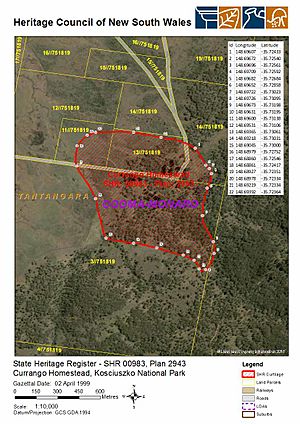Currango Homestead facts for kids
Quick facts for kids Currango Homestead |
|
|---|---|

Heritage boundaries
|
|
| Location | Kosciuszko National Park, Snowy Monaro Regional Council, New South Wales, Australia |
| Owner | Office of Environment and Heritage |
| Official name: Currango Homestead | |
| Type | state heritage (built) |
| Designated | 2 April 1999 |
| Reference no. | 983 |
| Type | Homestead building |
| Category | Residential buildings (private) |
| Lua error in Module:Location_map at line 420: attempt to index field 'wikibase' (a nil value). | |
Currango Homestead is a special old farm and home located in Kosciuszko National Park in New South Wales, Australia. It's a "heritage-listed" place, which means it's important to history and protected. The government's Office of Environment and Heritage owns it. Currango Homestead was added to the New South Wales State Heritage Register on April 2, 1999.
Contents
A Look at Currango's Past
Currango Homestead was once part of a much larger farm called Currango pastoral station. It was built in 1895 by a man named Arthur Triggs.
Currango Joins the Park
In 1944, Currango Homestead became part of what was then called Kosciusko State Park. Even though it was part of the park, people continued to live there.
Currango Today
Today, caretakers live at Currango Homestead. They also rent out the property to tourists who want to stay in this historic place. It's a unique way to experience the park.
What Currango Looks Like
The area around Currango Homestead is very beautiful. It has simple wooden buildings and older farm structures. These are surrounded by interesting plants and trees.
Special Trees at Currango
Some of the trees, like the tall Port Phillip pines, stand out. They act like a landmark for people traveling through the area. There's also a mature Himalayan or blue pine with long, curved cones. These trees show how people managed the land and lived off it in the past.
Why Currango is Important
Currango Homestead is a very important historical site in New South Wales. It helps us understand how Australia was settled. Early farmers spread out quickly, looking for new land for their animals.
A Place for Summer Grazing
Currango shows how people used the mountains for farming. Farmers would bring their animals to the high country during summer. This helped them find food for their livestock and escape droughts. Currango is the largest and most complete old farm in the snowy mountains. People have lived there almost continuously since the 1830s.
A Symbol of Mountain Life
This homestead has become a symbol of toughness and old ways of living in the mountains. Many people feel a strong connection to Currango. In 1975, a group called the "Friends of Currango" formed. They still help support the homestead today.
Important People and Stories
Currango is linked to early farmers like Thomas O'Rourke and Arthur Triggs. These people were important in developing the region. The Taylor family, including Tom, Molly, Ted, and Helen, were also very important caretakers. They kept alive the tradition of welcoming visitors to Currango.
Aboriginal History
The Currango area also has a rich Aboriginal history. It shows how Aboriginal people lived in and used the mountains long ago. The site is important to the local Walgalu and Wiradjuri Aboriginal communities. It reminds them of their ancestors' presence in the high plains.
Currango Homestead was officially listed on the New South Wales State Heritage Register on April 2, 1999.

